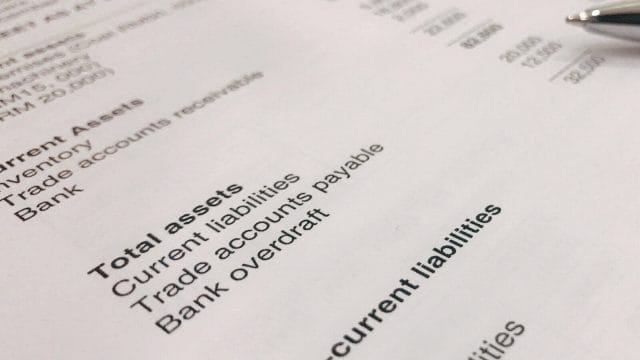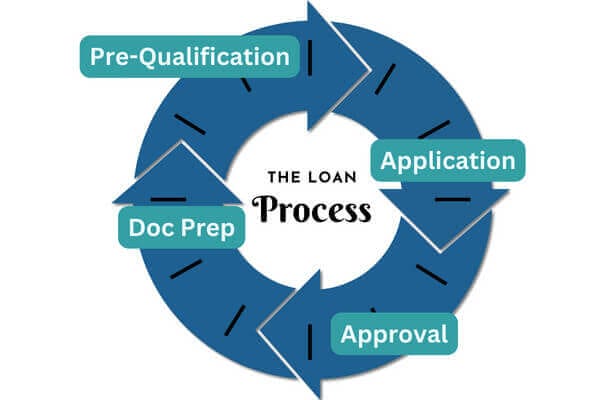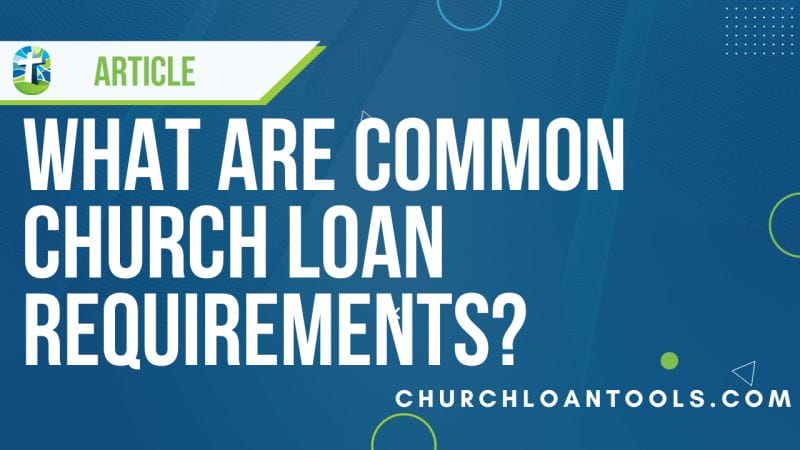
Are you looking for a loan to purchase a church property or a church loan refinance but unsure what to expect. This article will give you an overview of the church loan requirements credit unions, traditional banks, and most lenders will require.

Are you a new church?
The first place to start is when the church was founded. Before you can borrow money, the church (organization) must have existed for a minimum term. Most lenders require the church to be three years or older.
Exceptions exist, such as the case of church plants that were a remote campus for a larger church. However, before you borrow money, it is a good idea to gather your nonprofit organizations documents and verify that it has existed for at least three years.
Organization Documents
At a minimum, these document the entity name, official date established, and officers. Typically they are Articles of Incorporation, 501(c)3 recognition letter, Employer Identification Number (EIN), or others.

Financial Statements
When you apply for a loan, the lender will require financial information. The typical report will include a Balance Sheet and Profit & Loss. In nonprofit terms, this would be the Statement of Financial Position and Statement of Actives. Where the Balance Sheet is equivalent to the Statement of Financial Position and Profit & Loss is identical to the Statement of Activities.
Despite advancements in nonprofit reporting tools, overwhelmingly, the tool used to prepare nonprofit financial reports for churches is still Quickbooks. This means the reports use for-profit terminology. If you know where to look, Quickbooks and nonprofit specific reporting tools present the same information. However, it is good to know the naming convention for the main financial reports prepared for nonprofit financial reports vs for-profit entities.
The Most Common Reports
Balance Sheet | Statement of Financial Position
Reflects the financial position of an organization as of a specific date in time. The contents represent the assets of the organization and the funding sources, either loans or equity.
At a glance, the Balance Sheet will show if the assets were paid for by obtaining a loan or from funds retained from donations. The more loans obtained, the more restrictive cash flow is, and potentially higher interest rates can make it tougher to do ministry.
Profit & Loss | Statement of Activities
Shows all income sources (tithes and offerings) and expenses for a given period. For a clear picture, the Profit & Loss must include general and restricted income and expenses of the church.
At a glance, the Profit & Loss will show if there is a positive net income after paying all bills in a given period. Remember that a positive net income does not mean positive cash flow. Check out my article on Church Cash Flow to learn more about what affects your cash flow and how bankers calculate your cash flow for loan consideration. This is one area I highly recommend church leadership is familiar with.

What is a financial package?
When applying for a church loan, the first step financial institutions take is to work on “prequalifying” the loan request. This means they superficially review the financial reports and big picture of the project to ensure it matches the risk level they are willing to take on.
To get a clear picture, financial institutions need at least three years of financial reports to review. This is why a new church typically does not qualify for a loan, even if they have an existing loan.
At a minimum the financial package for a church includes:
Past three years fiscal yearend financial reports
Most recent interim financial reports
Fiscal Yearend
The end of the year for the organization. To work with the operating needs of the church, the fiscal yearend can vary buy most churches have a fiscal yearend of December 31. An example of when the fiscal yearend is changed is in the case of a church with a school beyond a simple ministry. In these cases, the church will change their fiscal yearend to Sept 31, but it can be whatever works for the needs of the church.
Interim
Any partial period within a fiscal yearend.

Reporting Period
Most reporting tools allow you to create a report for any period you want. It is important that the reporting periods are through the end of the month. The reporting period should begin with the first day of the fiscal year, and go through the last day of the fiscal year.
For example, a church that has a standard fiscal yearend will have a Balance Sheet (Financial Position) dated December 31. The Profit & Loss would contain all income and expenses for the period of Jan 1 through December 31.

I like to think of these two reports as a movie. The Profit & Loss is a range of time or a scene from the film, and the Balance Sheet is the last frame in the scene.

The Loan Process
As you might expect, the church loan process will vary from lender to lender, but you can expect it to look something like the following:
Pre-Qualification (“EOI/LOI”)
Submit a loan application (“Underwriting”)
Receive formal approval
Doc Prep/Closing
Pre-Qualification
The first step is talking to lenders to get on the same page about the project. The pre-qualification step achieves that. From the initial conversation, the lender can understand the loan request, and you can get an idea of their interest in the loan.
For the typical lender, this step has a limited amount of weight. The lender is not guaranteeing the interest rate or other terms of the credit request. Further, it is not stating the loan will be approved. The terms can change substantially before it is approved.
During your conversation, note your desired interest rate and loan payment. Do you plan to pay off the loan quickly, let your lender know. All this information has an impact on receiving competitive rates for your church.
This is also a great point to ask about covenants, banking requirements, and any other terms the lender might require as a condition of financing the church loan. Knowing the financing terms up front will save you from heartache at closing. The interest rate and payment are not the only things to focus on, and in times of economic stress, the covenants and conditions can have a bigger impact on your viability for your church than interest rates. Get the complete information on potential requirements up front.
Once the lender has enough information to determine they are interested in the loan request (or project), they will provide a document that outlines the potential terms and conditions of the loan. Of the many names, Expression of Interest (“EOI”) or Letter of Interest (“LOI”) are the most common references; they mean the same thing.
Submit A Loan Application (“Underwriting”)
Once you accept the terms of the EOI and are ready to move forward with a particular lender, they will ask for additional documentation to complete the loan package before submitting it to underwriting.
Third Parties
Underwriting the financing of a church loan requires obtaining information from third parties like a title officer and an appraiser and ordering an environmental report. The cost depends on the demand, turnaround time, and property location.

Receive formal approval
This is an exciting step in the process. With an Approval Letter, you know you have a solid loan offer for your church.
Just as before, the details matter. Review the EOI and compare the two documents for any changes to the financing terms. Before you sign the Approval Letter, ensure you have all your questions answered. It is better to discuss everything before you are at the closing table.
It is worth noting that some lenders streamline the process by negotiating loan terms upfront. In this case, the EOI “has teeth.” This is a term I use to imply that the key leadership team of the bank has reviewed the terms in the EOI. Unless the terms change during underwriting, you will not receive an Approval Letter. I prefer this method and find my clients like it as well.
Doc Prep/Closing
This is the final step in the church loan process. As before, review all the documents to verify everything matches your expectations. If you have a question, stop and get clarification.

Closing Thoughts
With some preparation, the church loan process is straightforward. The most important thing to remember is to ask questions. Take your time to understand the terms and conditions before you sign the documents for your church loan.
Finally, the church should stand on its own for the credit request, or it may not be the best time to secure financing. Not to say there is never a scenario, but I cannot think of a situation where I would encourage church leadership to personally guarantee church financing.

